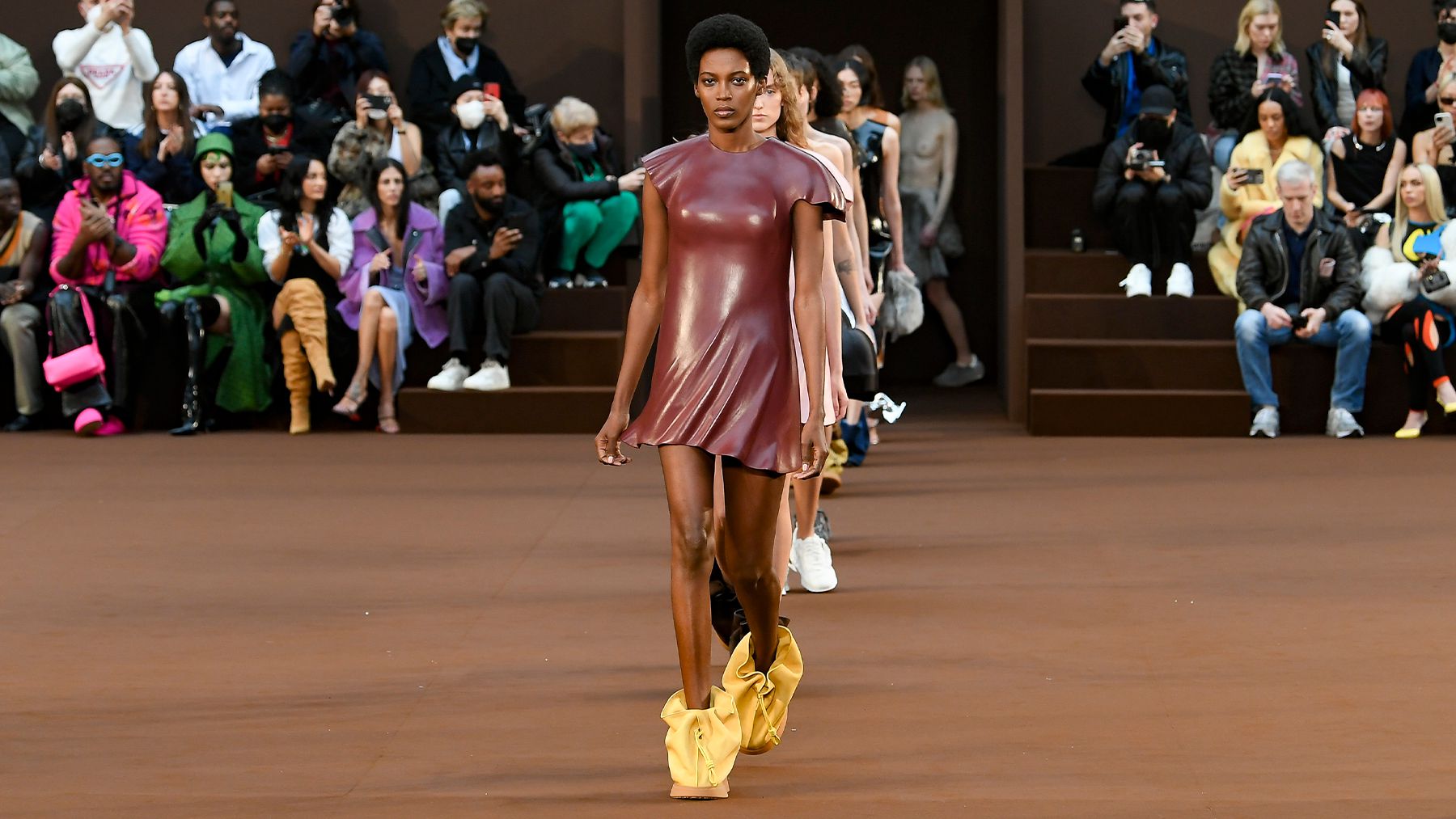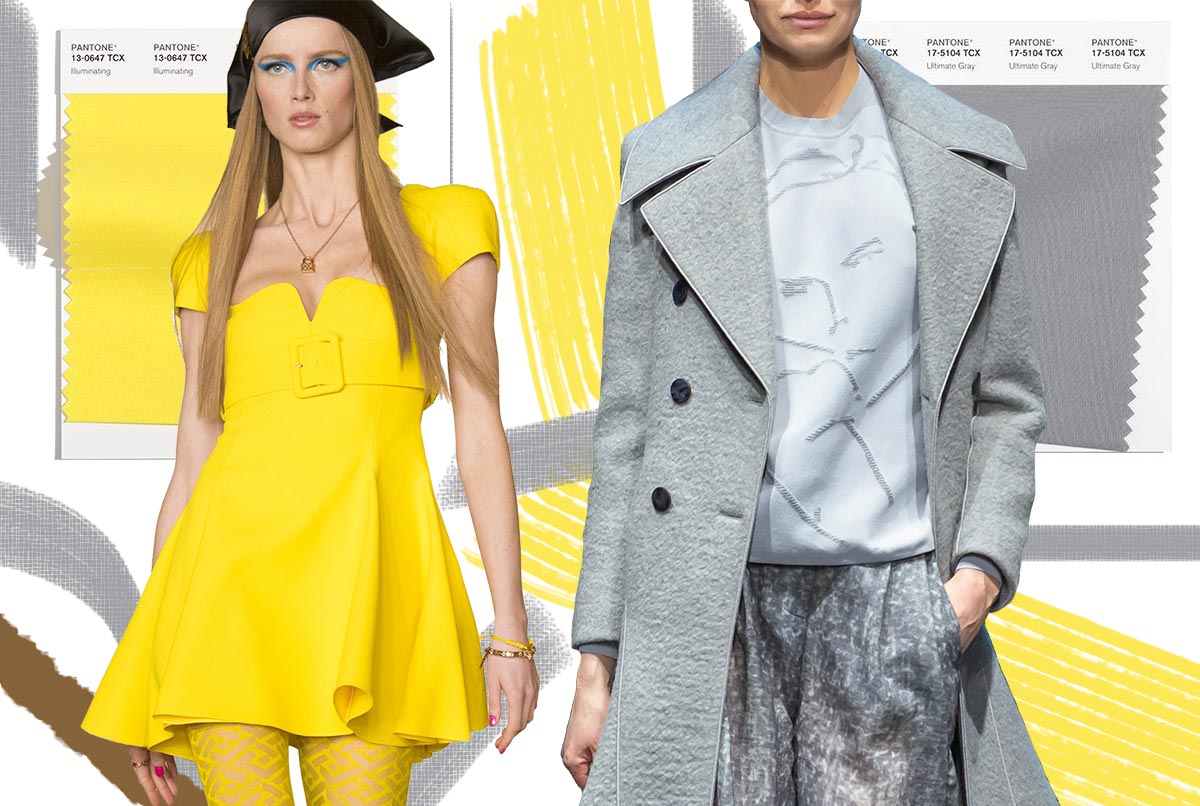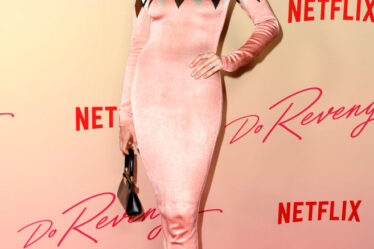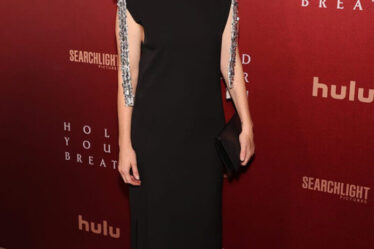
Images and Article from www.businessoffashion.com.
PARIS — The fashion week that closed on Tuesday offered a lot of food for thought about the way we experience things today, scrolling infinite feeds where bursts of horror blend with outpourings of frivolity and somehow everything is about me, me, me, even activism for a good cause. It’s not the first time in recent history that war has broken out during fashion month, highlighting the difficult contrast between a sector that serves the privileged and those who pray only to survive, but the invasion of Ukraine feels particularly close and particularly evil. And yet, the show goes on, and with it the social media circus that amplifies the action, despite calls for sobriety.
Amidst the parade of idols was mega-influencer Kim Kardashian, whose presence at Balenciaga (wrapped in yellow Balenciaga-branded tape) felt out of place, detracting from what was otherwise a very powerful show. Of all the designers addressing the war, Demna is the one who did it with the most legitimacy, having himself lived through Russian aggression, forcing him to flee his homeland of Georgia for Germany thirty years ago. “Once you are a refugee, you are [a refugee] for the rest of your life,” he said backstage, visibly shaken.
The show was potent to say the least, resulting in a kind of gesamtkunstwerk that started as a study on climate change but turned into something else entirely. The models — barely advancing through a “manufactured” blizzard in high heels, clothes shredded to pieces, bin bags in hand — looked like refugees traversing a nuclear winter. This kind of commentary from another brand might have come across as fetishizing human suffering. But in Demna’s hands, it all made sense.
What’s more, the hybrid, multi-purpose pieces he showed, as well as the pullovers and packable items, moved the widely influential Balenciaga code forward. This was the familiar Balenciaga in terms of shapes, but not entirely so and that was good.
The future, pauperism and primitivism were hot topics elsewhere in Paris, too, reflecting times that seem to be increasingly dominated by both new technologies and a kind of return to primal instincts. At the moment, the future does not conjure up galactic fantasies but on the contrary visions that are more earthly and carnal.
At Courrèges, Nicolas Di Felice took a bold leap forward and imagined a graphic, accelerated idea of sexy, all geometric shapes and short hems. Whilst being faithful to the house’s peculiar brand of futurism, Di Felice keeps morphing things to his own fast-paced point of view, and the result is impactful. Meanwhile, there were hints of the future at Dior, where padded, protective bustiers and inflatables made for a fresh, almost robotic take on the new look silhouette, until things reverted back to business as usual: Maria Grazia Chiuri’s best-selling recipes. There were whiffs of futurism and protection, mixed with frothy hints of rococo, at Balmain, too, and it felt fresh.
We also went back to the caves this week. At Acne Studios, looks were torn, tattered, put together by way of mending, but the result, instead of post-atomic, felt primal, and very sensual. More wrapping, knots and layers made for a strong outing at Ottolinger, where a blend of primitivism and body consciousness proved powerful. Yohji Yamamoto delivered yet another poetic vision in scissored black. But it was Rick Owens who took the primal to new heights with a celebration of raw beauty and its power to conjure hope. Immersed in fog, towering on high heels and wedges, walking slowly to Mahler’s soothing notes, Owens’ creatures oozed a distant but oh so human elegance. Perhaps survivors of an apocalypse, perhaps pioneers of a new world, they heralded the eternal sense of grace that touches both the eyes and the soul.
In hard times, beauty can matter more than ever, and in fashion few things signal beauty like Old World elegance, which is feeling very relevant again. The elongated silhouettes at Saint Laurent stood out in their mix of fragility and strength, flimsy chiffons and sturdy felts. With this collection Anthony Vaccarello made a giant leap forward, maturing out of the skimpy miniskirts and overt sexiness into something softer and more welcoming. Giambattista Valli translated the freedom of Parisian women into a vision of sharpness, froth and sass that felt lively and personal, while a couture-like stress on the hips and volumes made for the boldest Sacai outing in a long time — a sophisticated proposal attuned to metropolitan life — and Dries Van Noten opted for an elegance full of sensuality and sparkle.
Valentino’s Pierpaolo Piccioli is an everlasting purveyor of beauty, elegance and grace, which this season was doused in Day-Glo pink to the point of visual saturation. By stripping things back to a single colour, Piccioli meant to make a bold fashion statement, avoiding distraction to focus on silhouette, cut and texture. The results were mixed. Bright pink occupies one’s whole visual space, and all you perceive is pinkness. The pieces that looked best were the smattering of black silhouettes: in those, Piccioli’s quest for elongation, and his sensible way with sensuality and shape really stood out, and one could really appreciate the textures, the cuts, the materials.
Minimalism meanwhile made a comeback, in a variety of iterations. It was pure Calvinist fashion nun stuff at The Row, while pared down beige took a sassy, “look-at-me” turn at Ludovic de Saint-Sernin. The tailoring at Gauchere was outstanding for its simplicity, sharpness and ease, while at Ann Demeulemeester it was monastic looks with high slits that felt desirable, but devoid of the intensely romantic sense of rebellion that always made the label so special.
Speaking of minimalism, Francis of Assisi, who renounced wealth and became a saint, appeared on the Chloé collection notes as none other than the first environmentalist, sustainability being the company’s mantra since Gabriela Hearst took the creative helm. Historical inaccuracy notwithstanding, the collection looked very minimalistic, too, and rather dry, with an unexpected abundance of black and only in the ponchos worn with hiking shoes a vague remnant of the house’s bohemian past. In other words, Chloé keeps changing, its new identity not yet fully formed.
The fascination with youth is eternal, but this season, on the wavelength of “Euphoria,” it took a clear turn towards high school. There were school lockers, and endless reworkings of Y2K tropes at Coperni. At Louis Vuitton, Nicolas Ghesquière dedicated the entire collection to youth, to the unresolved poetry of adolescence and its romanticism and idealism. The not so subliminal message was one of hope for the future, a wish for a better world. Curiously, it had a nostalgic tone: Ghesquière was clearly referencing his own adolescence, a time when Giorgio Armani was sending women in neckties down the catwalk. The big sweeping volumes, the humongous tailoring, the freewheeling ease felt very ‘80s, in fact, and not very exciting.
At Givenchy, Matthew Williams seemed to put in maximum effort with little result, though the designer managed to find a balance between Hubert de Givenchy’s sense of chic and his own metropolitan proclivities, between archive and present, between grace and roughness. There were obvious echoes of Balenciaga, mixed with references to Riccardo Tisci’s Givenchy, making for a palatable if unoriginal proposal.
The tweed galore at Chanel was a clear attempt to refresh the house staples in youthful ways, but the outcome was mixed. Miu Miu, meanwhile, stuck to last season’s hit recipe, but added new shapes and a dash of gender bending. It worked, youthfulness oozing from the label’s deranged take on classics.
In a random world, never underestimate the power of a random act. Stella McCartney’s brand of female empowerment came through in random but charming ways, and there was plenty of puzzling randomness at Off-White, highlighting how much the appeal of the brand was Virgil Abloh himself and his unparalleled communications skills.
But it is Jonathan Anderson who keeps elevating randomness to art form, pushing the envelope each season a bit more, bravely venturing out of his own comfort zone. Anderson has turned Loewe into a psycho-aesthetic research laboratory. Since last season the Spanish brand, of which Anderson has been creative director since 2014, has entered a wildly surrealist phase. By inserting himself into the imaginative void created by the temporary absence of Rei Kawakubo on the Paris schedule (the designer showed in Tokyo this morning), Anderson keeps creating collections that displace the viewer and avoid easy explanations; collections charged with brutal and flagrant surrealism, at once intriguing and irritating. This season it was a big bang with kinky flavour and lots of balloons, complete with car-dresses, that cast a spell on the audience. It was just the kind of ode to the power of the imagination that humankind desperately needs.
Article shared from www.businessoffashion.com



